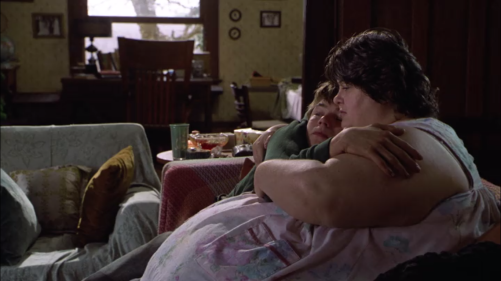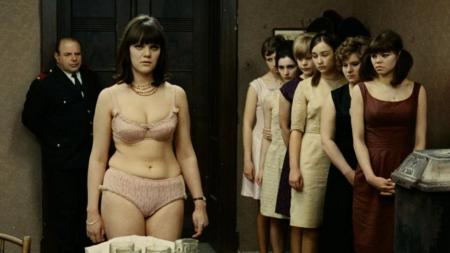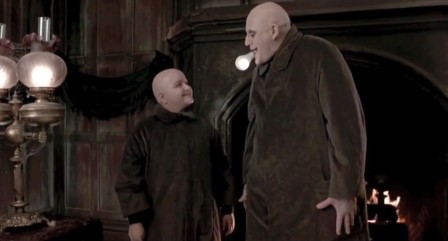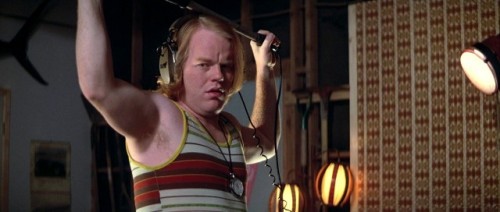“Thou sayest thou didst see the god clearly; what was he like?”
“What his fancy chose; I was not there to order this.”–Euripides, The Bacchae
Something I’ve always struggled with as the sole writer of this blog is the best way to include discussions of people of color. Similarly to how Laura Mulvey famously observed that films are largely produced for an assumed (straight, cis) male audience, the US film industry largely also operates under the assumption of a white audience. Often protagonists or other empathetic characters are white (traditionally of the WASP variety), while characters of other races or ethnicities are distanced from the audience. As a white person, I am able to analyse and criticize what a film tells me about the people of color it depicts. On the other hand, what I have to say is less vital to conversations about race in media than people speaking about how they see themselves. The lack of intersectionality in film often means little space for fat people of color, but when they are characters in film, they need to be included in the conversations I try to have on this blog– not with the intention of speaking over people of color talking about their own experiences and opinions, but rather to ensure that this blog is as inclusive as possible when looking at fat film characters.
That being said, last night I watched Moana for the first time. Considering that Disney is, well, Disney, the amount of care they took in representing Polynesian cultures is notable, including an almost-all-Polynesian cast (I believe Alan Tudyk, who voices HeiHei the chicken, is the sole exception) and seeking approval from cultural experts before finalizing designs. Plus, the titlular character (Auli’i Cravalho) is a courageous leader of her people whose adventure isn’t sidetracked by a compulsory romantic subplot. As “Polynesian” is an umbrella term for many cultures and nationalities, the film’s world is a pastiche, with Moana being a character created by Disney and hailing from the fictional island of Motunui.
The other principal character, the demigod Maui (Dwayne Johnson), is a figure in legends across Polynesian cultures. He’s also the reason I’m writing this post: Moana’s Maui is a big dude. Before the film’s theatrical release, there was pushback against his character designed from New Zealand Parliament Member Jenny Salesa, Samoan rugby player Eliota Fuimaono-Sapolu, and others, that “the depiction perpetuates offensive images of Polynesians as overweight,” as noted in this NY Times article about the development of Maui’s look for the film. A similar article from The Guardian, focusing specifically on the controversy, quotes Will Ilolahia of the Pacific Island Media Association stating that a fat Maui is “typical American stereotyping,” contrasted with Maui’s depiction in his culture’s stories as “a person of strength, a person of magnitude and a person of a godly nature.”
The articles quote other Polynesian folks who saw Maui’s size as an indicator of strength. The Guardian article includes a YouTube video by self-described “obese Polynesian” Isoa Kavakimotu who defends Maui’s body as “all about function, not aesthetics.” (The video is worth watching, but be aware that it has a lot of flickering images.) Samoan artist Michael Mulipola interpreted Maui’s physique as that of a traditional animated sidekick, noting that Maui’s “thick solid build represents power and strength,” and is “reminiscent of old school power lifters.” David Derrick, an artist who worked on Moana and is of Samoan descent, made an insightful observation in the NY Times article: “I think a lot of those things come from people being very nervous and scared that a big company is portraying this beloved cultural character.” Given Disney’s history– hell, given the history of big companies using cultural objects to create a product for mass consumption– that’s pretty fair.
Derrick’s comment called to mind the depiction of Dionysos/Bacchus in the Pastoral Symphony sequence in Disney’s Fantasia. (The Bacchanal starts at 11:05 in the linked clip.) I’m much more familiar with Greco-Roman legend than I am Polynesian, and therefore am more confident in calling out Fantasia as an example of a cultural object being distorted for mass consumption. The NY Times article points out that Maui is traditionally represented as a slender young man; the same is true of Dionysos in ancient Greek art. Although always the god of wine, to the ancient Greeks, he was much more: a personification of the wild, the invoker of divine frenzy. His ceremonies honoring him served as a ritualized transgression of social order. In many traditional stories, including Euripides’ drama The Bacchae, he calls women to join him in ecstatic revelry in the forest, away from their roles as wives and mothers. In the Fantasia sequence, outside the context of his culture and de-fanged for a modern Christian audience, he is a stereotypical drunk. The satyr and centaurs who revel with him are in contrast both in their slender bodies and their behavior. Their dancing is neatly choreographed; they manage to keep Bacchus as on-track as possible. The female centaurs flirt with him but never allow him to get too close. They remain in control of themselves and the situation, a Homeric social guidance film. Bacchus is not effeminate, as Dionysos is described in Greek stories to suggest that he occupies a space outside social categories; rather he is emasculated, his wildness stripped of its divine power. He’s merely “let himself go,” his fat body a symbol of excess that is tolerated for a joke but never fully embraced by those surrounding him. Does Maui suffer the indignity of a similar process at the hands of Disney studios, 66 years later? Even if he isn’t the protagonist, Maui does retain his heroic status in the film– he’s strong, brave, clever, and embarks on a heroic adventure to save the world. Does the fact that he has a fat body, as opposed to previous artistic depictions, detract from his other characteristics?
Searching online for a source to unpack the stereotype of fat Polynesians is proving difficult– I’m just turning up a lot of articles on reactions to Maui’s character design. (Interesting sidenote: the titles of many of these articles describe Disney as “fat-shaming” or “body-shaming” Maui… drawing a character with a fat body is not “shaming” them, but no worries, it’s not like you’re being paid to use words accurately or anything.) The pushback that I’ve seen is specifically focused on Maui’s size, and unfortunately there doesn’t seem to be much of an explanation beyond that, suggesting that fatness is objectively and simply a bad thing. Why is that the case, at least in the context of this discussion? Assumptions about health is a likely suspect. The Guardian article mentions the high obesity rates in several Polynesian countries, as reported by the World Health Organization. Ilolahia’s statement suggests a connection between size, health, and colonialism. Even in Kavakimotu’s video defending Maui, he conflates fatness with unhealthiness, concluding that Maui isn’t fat/obese because of his physical prowess. This is where we venture once more into the murky, mutable definition of what it means to be fat. The reactions to Maui that I’ve seen thus far buy into the oversimplified narrative of fatness and health having an inversely proportional relationship. It feels a bit cheap to point out that Maui is a cartoon character and a magical one at that, so questions of his health are somewhat moot to begin with. But in the real world, athleticism and body size are more complicated than what’s being suggested. While watching Moana, I asked myself if the desire to see Polynesian representation in film wouldn’t be better fulfilled by rewatching Whale Rider (to be honest, there was a lot about Moana that I found underwhelming). And that thought came up again when reading about this controversy, considering that in Whale Rider, protagonist Pai (Keisha Castle-Hughes) is trained to fight with the taiaha by her fat uncle Rawiri (Grant Roa).
Undoubtedly, the history of colonialism and racism continues to impact the quality of life of communities across the globe, including Polynesian folks. And by not looking critically at what is implied when we talk about fatness leaves a lot unspoken about what kind of hurtful attributes get assigned to certain communities, and why. But what is accomplished by suggesting that a fat character who comes from a marginalized community doesn’t belong in a heroic position, or even belong at all in a story about that community? In fact, Maui is the biggest (human) character in the movie; does having a range of body types depicted still result in the promotion of a stereotype? And considering that Maui’s character development redeems him as a hero in the eyes of his people, what the criticism of his body ultimately leads me to wonder is: where is the line between calling out stereotypes and playing into respectability politics?





















